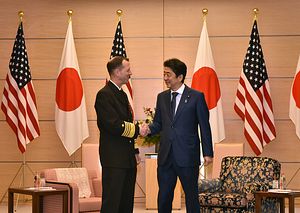The U.S. Chief of Naval Operations, Admiral John Richardson, is wrapping up a tour of the Western Pacific that included visits to U.S. forces in Korea and Japan, as well as visits with allied leaders in the region. In addition to emphasizing the U.S. commitment in the face of what he called the “unprecedented and urgent threat” posed by North Korea’s increasingly capable nuclear arsenal he made particular efforts to provide encouragement to the U.S. Navy’s forward-deployed forces who have been rocked by a series of tragic marine and aviation mishaps this year that have killed at least twenty sailors.
Admiral Richardson told sailors in South Korea that they were on “the tip of the spear,” that the nation was proud of them, and how important their work was to providing stability on the peninsula. He later took the opportunity to tell Japan-based crews how valuable and respected they were, and that the message he received on his trip was how important their presence was provide assurance to allies and partners in the region.
At a briefing onboard the Japan-based carrier USS Ronald Reagan Admiral Richardson reiterated that the U.S. Navy would meet all of its mission requirements in the Western Pacific by bringing units forward from the California-based Third Fleet or elsewhere, which is standard practice to supplement the Japan-based Seventh Fleet.
The deadly collisions of the USS Fitzgerald and USS John S. McCain in separate incidents with civilian merchant ships raised questions about the Seventh Fleet’s readiness and exposed training practices that allowed ships’ certifications to conduct operations to lapse. The incidents have led to two separate reviews by the U.S. Navy, each with sweeping recommendations to change practices and how the Navy does business.
Admiral Richardson’s comments to crews in Japan emphasizing their contribution and his respect for the job they do contrast in tone with testimony that Admiral William Moran, the Vice Chief of Naval Operations, gave to the U.S. Congress following the two collisions. Admiral Moran told the House Armed Services Committee that he had assumed that Japan-based ships’ high operational tempo meant that they were the most experienced and ready to operate, but that the Fitzgerald and McCain collisions demonstrated that his supposition was wrong.
However, it isn’t clear that the two ships’ lapsed training certifications contributed in any way to the mishaps. A combination of factors led to the widespread training gaps, from hectic operational schedules, tight funding, and an inadequate number of assessors to conduct all the necessary certification events. Additionally, the fact that Japan-based ships spend much more time at sea than most of the rest of the U.S. fleet, and that the waters they operate in are often much more crowded and perilous as well, may better explain why the recent mishaps have been concentrated in the Pacific.
The collisions will likely exacerbate the high operational utilization Japan-based ships face. The Western Pacific is home to some of the United States’ most vexing geopolitical challenges, from China’s growing and modernizing military, North Korea’s expanding nuclear capabilities, and complicated maritime rights disputes marked by intensifying “gray zone” tactics from China that the United States has struggled to effectively respond to. The Seventh Fleet’s ships were therefore already the busiest in the U.S. fleet and now the loss of the Fitzgerald and McCain will cause that tasking to be spread across even fewer hulls.
The loss of the Fitzgerald and McCain, whose repairs may take a year or more, represented 25 percent of forward-deployed destroyers. The damaged ships also made up one third of the Japan-based destroyers that perform ballistic missile defense (BMD). The BMD mission has taken on even greater importance following North Korea’s testing of intercontinental ballistic missiles earlier this year and the Trump administration’s stated commitment to denuclearization of the Korean peninsula.
New ships added to plug the gaps as Admiral Richardson promised must achieve a steep learning curve as their crews will lack the unique operational experience and institutional knowledge accrued by the two destroyers which have operated in the Western Pacific consistently for years. One of the ships that Admiral Harry Harris, the head of the U.S. Pacific Command, told reporters would be in Japan early next year to provide backup, the USS Milius, has been slated to join the forward deployed forces for years in recognition that the fleet was already too thinly stretched even before the two collisions.

































